
An Indian Helicopter Story
Mon, 21 Jun 2021 | Reading Time: 8 minutes

India’s Advanced Light Helicopter Program: Driving Rotorcraft Indigenisation
“The rotorcraft accords unparalleled flexibility and self-reliance across all three domains – indeed, a combat helicopter is the epitome of battle readiness across the conflict spectrum”.
Helicopters are an integral component of the Armed Forces in the effort to prosecute battle and to fulfil a major portion of combat support tasks. Rotary wing machines of course do also find intense utility in functioning of civil administration and with private players because of the advantages of ease of operation and relatively low requirement of infrastructural support to fly. Based on specific operational roles, the helicopter fleets of the three Services require to be tailor- made for various operational roles/ tasks.
While reliance on foreign firms for acquisition and collaboration for manufacture has been heavy in the past, the present push towards ‘Make in India’ underlines the need of increasing indigenisation in manufacture and supply of rotary wing machines to the Armed Forces. The Hindustan Aeronautics Limited (HAL) is the mainstay of India’s road to indigenization in this regard.
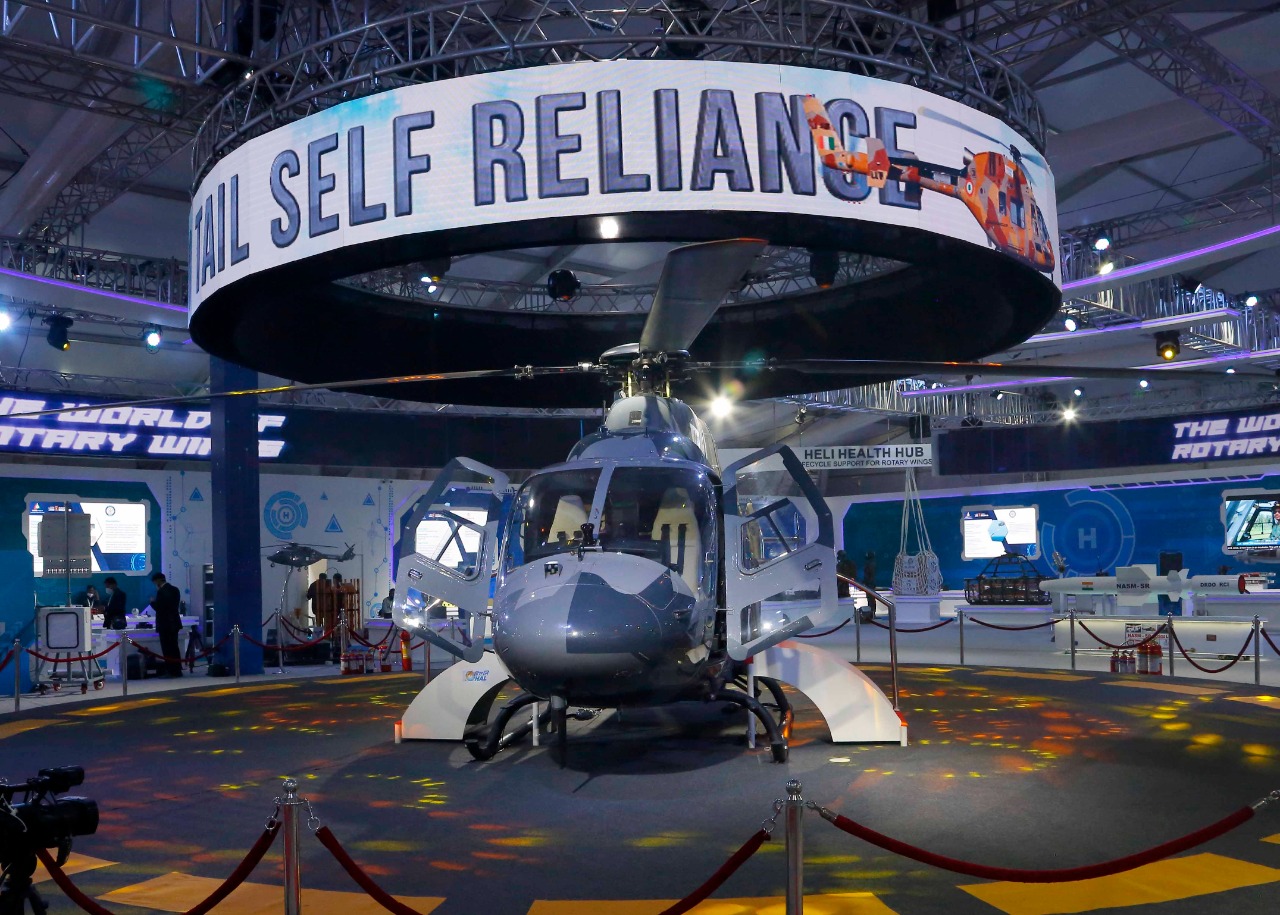
Image Courtsey: Aero India 2021
Why Did India Need an Advanced Light Helicopter (ALH) Program?
There was long felt a need to develop an indigenous helicopter program to meet the rotary wing requirements of the Armed Forces and for civilian use and in doing so wean away from the erstwhile approach of relying heavily on costly imports. The ALH Program therefore was conceptualized to cater for the Utility Helicopter needs of the Armed Forces, with later variants being designed / modified to fulfill other roles of combat / combat support.
The proposal for an indigenous 5.5 ton class multirole helicopter was initiated in May 1979 by the Indian Air Force (IAF) and Indian Navy (IN). HAL were awarded the contract by the Indian Government in 1984 to develop the ALH with German consultation. The first prototype ALH made its maiden flight on 20 August 1992 at Bangalore. This was followed by a second prototype in April 1993- an Indian Army(IA)/IAF version, and a IN specific prototype. The program was however besieged by the economic crisis in the early 90s and imposition of sanctions following the Pokhran-II nuclear tests in 1998. Initial Operational Clearance (IOC) for the ALH was subsequently issued in 2001 and induction of the Dhruv ALH commenced in 2002. The Indian Coast Guard (ICG) was the first recipient, followed by the Armed Forces and the BSF. The ALH is also used by civil administration, State police forces and private operators. ALH variants include the ALH Mk-I to Mk- III (Dhruv), ALH Mk-IV (Rudra), the Light Combat Helicopter (LCH) and the Light Utility Helicopter (LUH)- the latter two are yet to enter active service. The broad chronology of the ALH Program is given in the chart below.
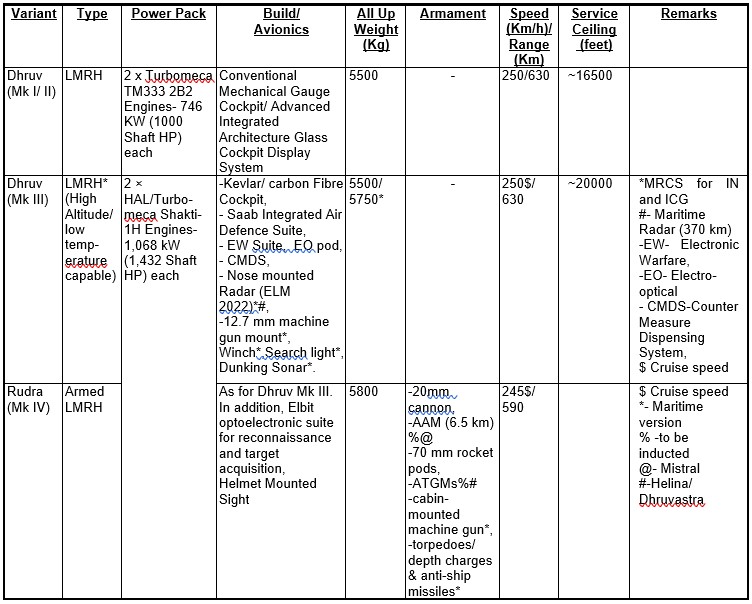
ALH Dhruv
Dhruv ALH is a light helicopter in the 5.5 ton weight class. Dhruv was “Type-Certified” for Military operations by the Centre for Military Airworthiness Certification (CEMILAC) in 2002. Dhruv Mk I to III (Utility Version) entered production between 2001 and 2010. Induction of Dhruv Mk III commenced in 2011, with IA being the first recipient, followed by the IAF.
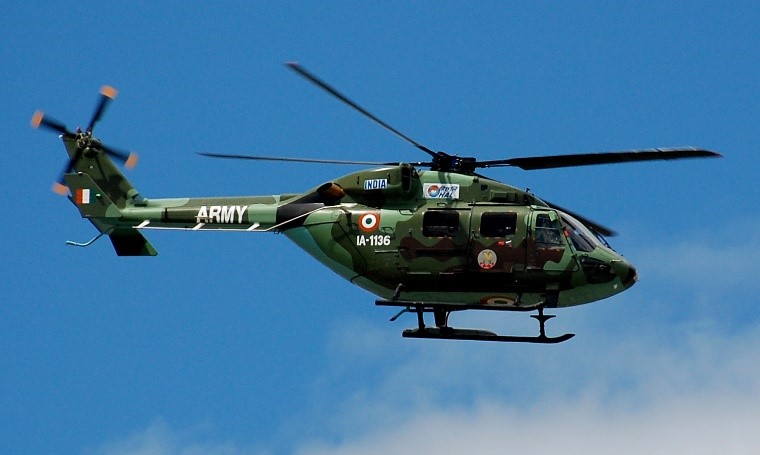
Dhruv ALH: Source – commons.wikimedia.org
Design Features. The Dhruv ALH is a Light Multi-Role Helicopter (LMRH) of conventional design with about 29% of its empty weight (constituting 60% of the airframe’s surface area) made up of composite materials. The helicopter design enables the crew to survive vertical impacts of up to 30 feet per second, due to the crash- worthy seats and fuselage crumple zones. The variants are produced in skid or wheeled (IN) versions. The two member crew ALH can carry 12- 14 troops in passenger configuration and when configured for casualty evacuation can carry two/ four stretcher patients. The communications suite includes HF, UHF, and VHF radio communications. Israel Aerospace Industries (IAI) has developed an integrated helicopter avionics suite for the Dhruv, including daylight and thermal imaging cameras, electronic warfare (EW) suite, and observation & targeting devices. Saab Avitronics has provided the integrated defensive aids suite (IDAS) self-protection system for the military version of the Dhruv. The Dhruv Mk III has emerged as a flexible multi-role helicopter system with niche performance in all-weather/ terrain configuration, wherein the ALH has proved its capability even in the Siachen Glacier, surpassing all expectations. As per recent inputs, IN and ICG, equipped with the older Dhruv Mk-I, are getting a maritime version of Dhruv Mark-III called the Maritime Reconnaissance and Coastal Security ALH (MRCS). Certain issues with the IN version including observations with folding rotor blades and tail boom for ship stowage are being worked upon. The IN has raised a Dhruv Mk III MRCS squadron with initial consignment of three machines in February this year, with the ICG following with induction of three MRCS on 12 June.
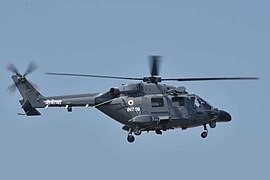
MRCS: Source – commons.wikimedia.org

ALH Mk IV (Rudra)
The ALH Rudra, (ALH-WSI), is a Weapon System Integrated (WSI) Mk-IV variant of Dhruv Mk III. While the Rudra is essentially an Armed Helicopter, the operational roles can include reconnaissance, troop transport, anti-tank warfare, and close air support. HAL was contracted to deliver 76 Rudra helicopters for the Indian Army and the IAF. The Indian Army plans to equip its Army Aviation Corps with 60 helicopters, forming six squadrons, while 16 are to go to the IAF. A total of 50 Rudra ALH are operational with the IA, with another ten machines in the process of delivery.
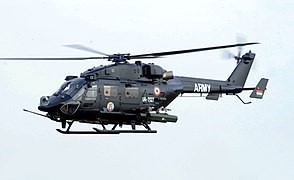
Rudra ALH: Source- commons.wikimedia.org
Design Features. The development of Rudra was authorised in December 1998. The prototype made its first flight in August 2007. IOC was accorded in February 2013. The airframe design of the Rudra is that of the Dhruv Mk III. The avionics suite, with add-ons over the Dhruv Mk III, integrates a Forward Looking Infra Red, Identification Friend or Foe (IFF) and Laser target ranging / designation, among others. The helmet-mounted sights, advanced ballistic computer and fixed sights ensure the pilots can accurately engage targets using onboard weapons. The machine has exceeded all payload and performance specifications at a high altitude of 6000 m. The performance of Rudra prompted the IN, which was not part of the original contract, to conduct flight trials and endorse suitability of Rudra for coastal operations. Subsequently, the IN has placed an order for 20 machines.
Perspective Road Map
India’s perspective road map under the ALH Program includes development of the LCH and the LUH. The development of the Indian Multi Role Helicopter (IMRH), a medium lift multi- role helicopter, is not part of the ALH Program and is therefore beyond the scope of this article. Similarly, rotary craft being planned/ acquired ex- import including the Kamov Ka-226T Utility Helicopter and the Apache AH-64E Attack Helicopter are not being covered here.
LCH
The impetus for development of the LCH emerged during the Kargil War of 1999, where the IA and IAF realised the requirement of a genuine attack helicopter capable of operating at high altitudes. The LCH program was subsequently launched by HAL in 2006. The LCH has drawn extensively from the design of the Dhruv ALH. The maiden flight of the prototype was consequently carried out in an expeditious timeframe on 29 March 2010. During subsequent test flights, the LCH became the first attack helicopter to land in Siachen, having repeatedly landed at several high altitude helipads upto 16000 feet! The LCH was declared production- ready in February last year. IA has committed to an order of 114 machines and IAF 65 machines. Limited Series production for 15 LCHs for IA and IAF at a cost of Rs. 2911 crores was cleared by MoD in Nov 2016, at an approximate cost of Rs. 200 crore per helicopter, about 50% of the cost of an Apache AH 64.

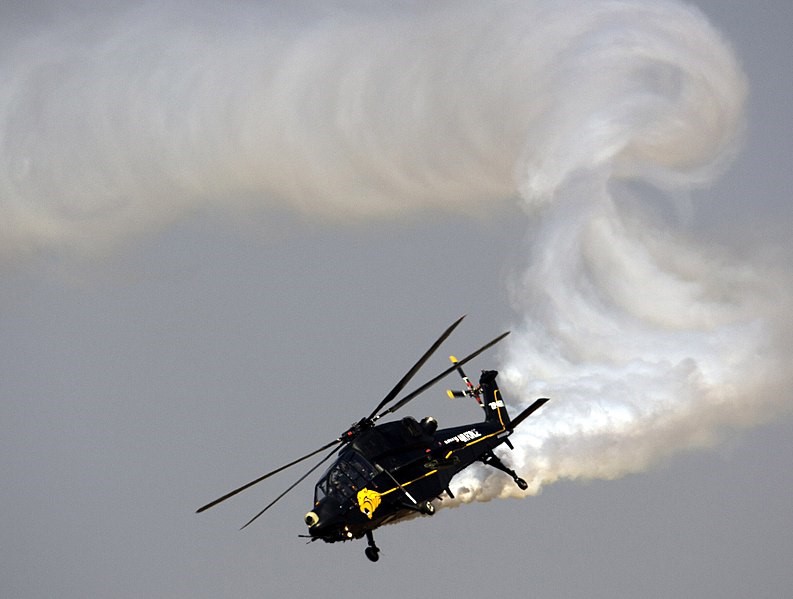
LCH: Source- commons.wikimedia.org Source- Aero India 2021
Design Features. The LCH is equipped with a two-person tandem cockpit, which serves to substantially narrow its fuselage profile. It possesses armour protection and is capable of day-and-night combat operations. According to reports, the protective measures include a digital camouflage system, referring to computer aided graphic camouflage design with wide applicability and angular construction to lower its radar cross section. The avionics, including the power pack, integrated dynamic system, hingeless main rotor and bearing-less tail rotor, have been inherited from the Dhruv and Rudra ALH. LCH also boasts a crashworthy tricycle landing gear arrangement and crashworthy self-sealing fuel tanks. The characteristics are tabulated below.
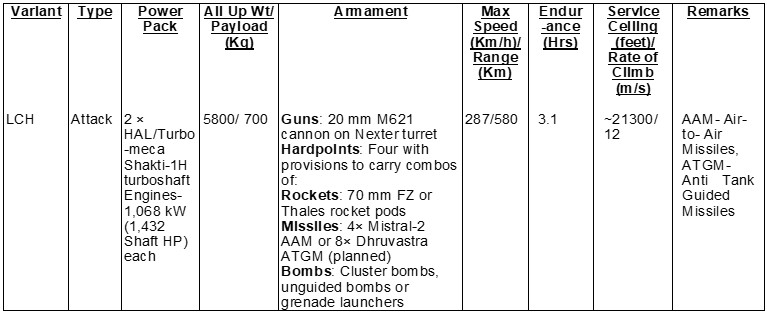
LUH
The LUH is being developed for both military and civil application and is subsequent to the 197 Utility Helicopter ex import deal with Eurocopter Fennec and subsequent firms which did not materialise. The LUH is expected to replace the ageing Cheetah and Chetak fleet of the Armed Forces. It is a 3 Ton class single engine helicopter capable of undertaking missions like reconnaissance, surveillance, search & rescue and troop transport. The first prototype flew in September 2016 and the final high altitude trials were completed in Siachen Glacier in September 2020. The LUH received the IOC for the IA in early 2021.The Indian Armed Forces have a requirement for 384 utility helicopters, of which 187 will be LUH, with the rest being fulfilled by a separate Russian Kamov Ka-226T order. Out of the 187 LUHs, 126 are intended for Indian Army and 61 for IAF. MoD has placed an initial order of 12 machines out of which 6 each are for IA and IAF. The first LUH will reportedly be delivered by mid-2022.
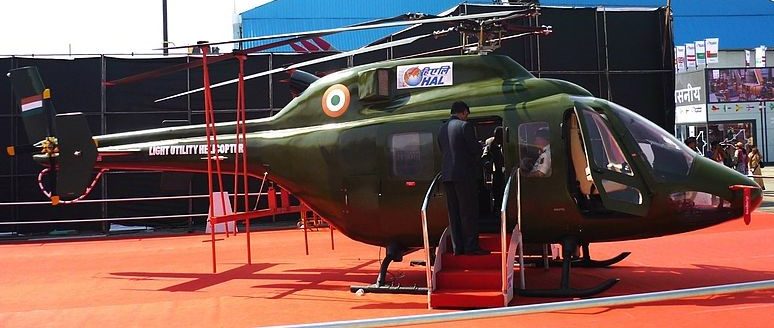
LUH: Source- commons.wikimedia.org
Design Features. LUH is equipped with a glass- cockpit Smart Cockpit Display System and state-of-the-art HUMS (Health & Usage Monitoring System). The LUH will be capable of accommodating two pilots and six passengers, with crash-worthy seats and will be capable of carrying external under-slung cargo upto 1 ton. It is powered by a single Shakti 1U Turboshaft Engine. A large part of the LUH avionics are derived from the Dhruv ALH. The characteristics are tabulated below.

Conclusion
The ALH Program was conceptualised with a vision to achieve an indigenous answer to the varied roles that could be assigned to a light, multi role helicopter. The ALH Program has pledged and continues to deliver on the promise of emerging as the mainstay of India’s light helicopter fleet. The several advantages that accrue from such a program including indigenous design, production and maintenance, can only go to further strengthen the National vision of Atmanirbhar Bharat through ‘Make in India’ for our Armed Forces.
************************************************************************************************************
Author

Brig Arvind Dhananjayan (Retd) has commanded an operational Brigade and has been Brigadier- in- charge Administration in a premier training facility. He has had exposure abroad on deputation to Botswana, Southern Africa as member of an Indian Army Training Team and has had extensive exposure in mentoring of Defence Forces overseas. He possesses vast instructional experience, imparting instructions in both technical aspects and tactical application of weapon systems.
Disclaimer
The opinions expressed in this article are the author’s own and do not reflect the views of Chanakya Forum. All information provided in this article including timeliness, completeness, accuracy, suitability or validity of information referenced therein, is the sole responsibility of the author. www.chanakyaforum.com does not assume any responsibility for the same.
Chanakya Forum is now on . Click here to join our channel (@ChanakyaForum) and stay updated with the latest headlines and articles.
Important
We work round the clock to bring you the finest articles and updates from around the world. There is a team that works tirelessly to ensure that you have a seamless reading experience. But all this costs money. Please support us so that we keep doing what we do best. Happy Reading
Support Us




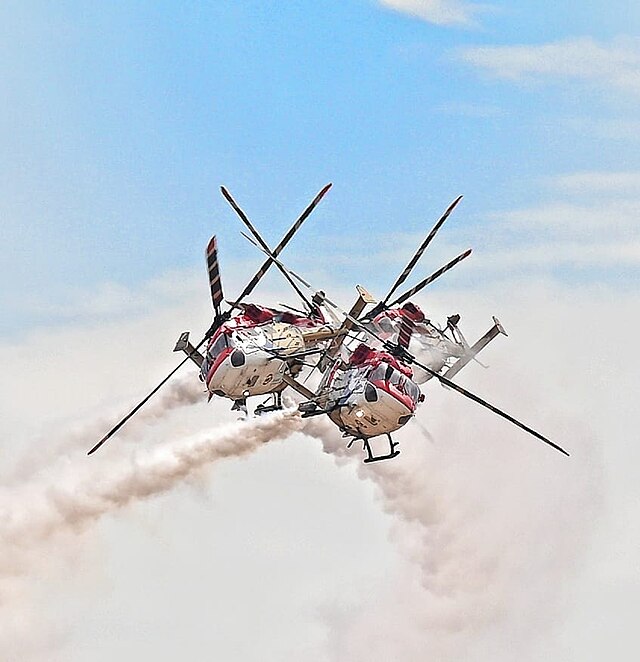
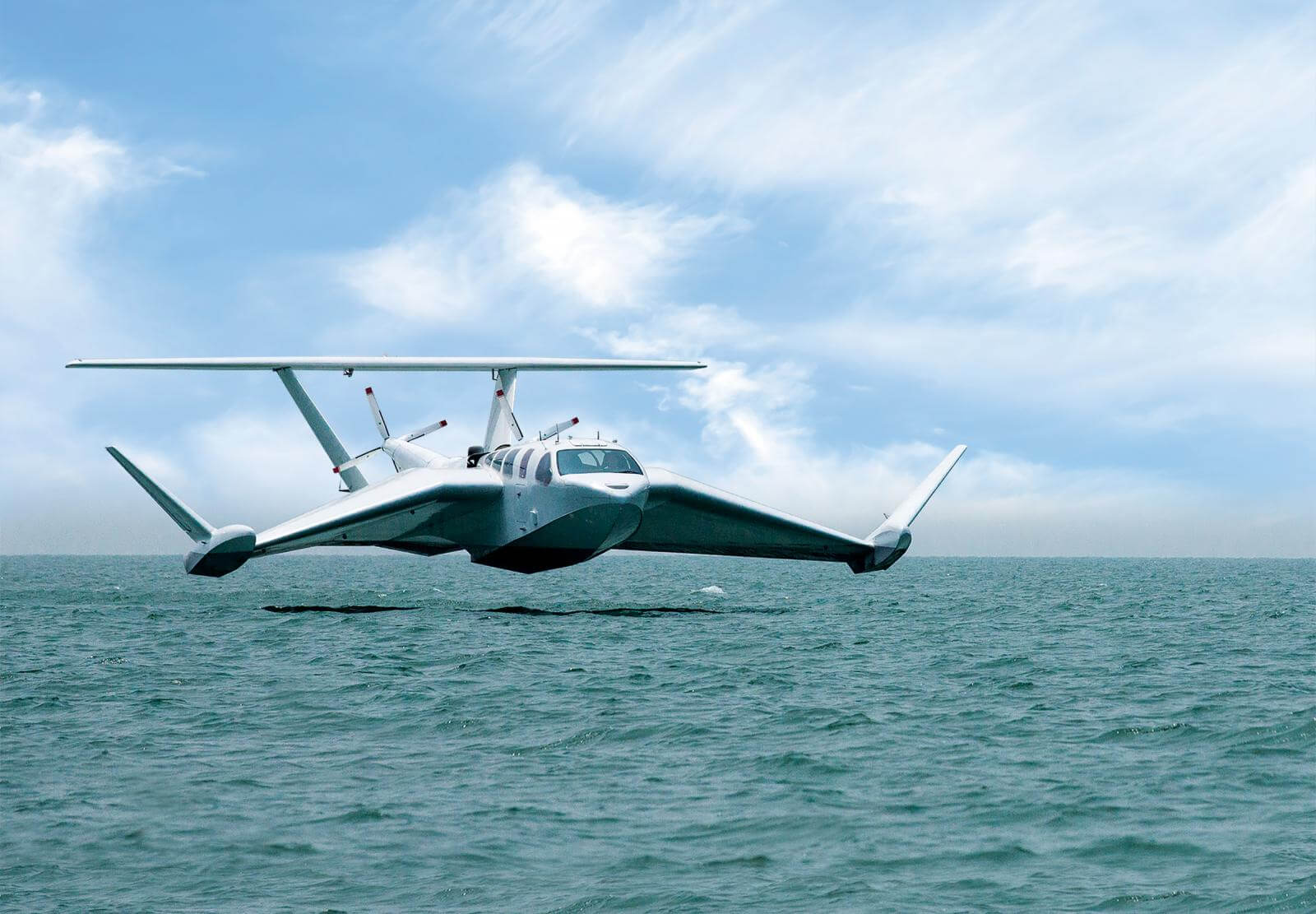



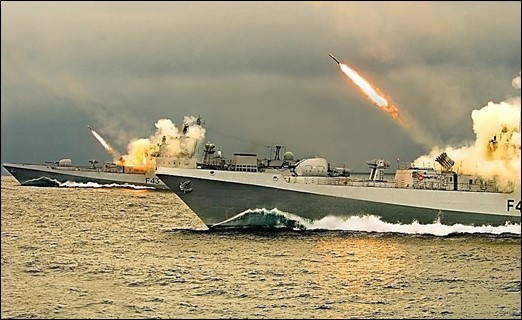
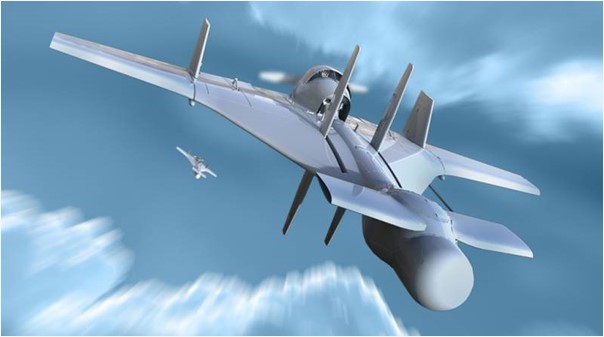
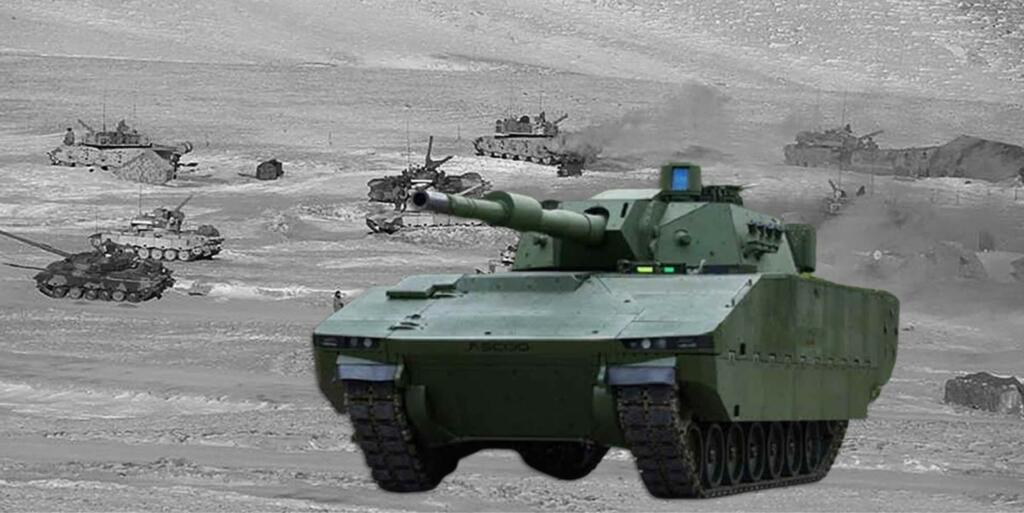

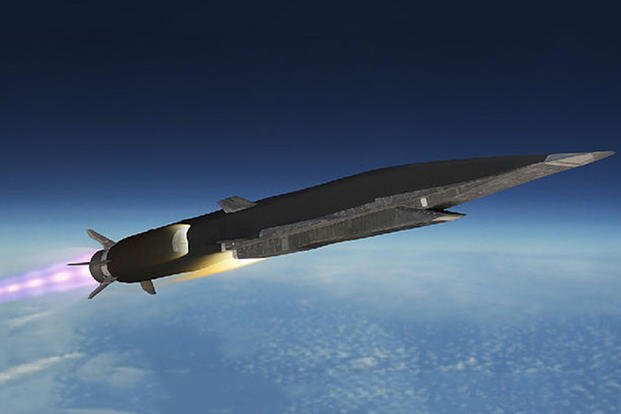






POST COMMENTS (3)
Kishlay Kumar
shivam singh
Rakesh Ranjan